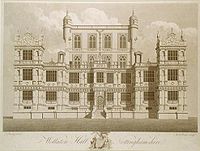
Robert Smythson
Encyclopedia


England
England is a country that is part of the United Kingdom. It shares land borders with Scotland to the north and Wales to the west; the Irish Sea is to the north west, the Celtic Sea to the south west, with the North Sea to the east and the English Channel to the south separating it from continental...
architect
Architect
An architect is a person trained in the planning, design and oversight of the construction of buildings. To practice architecture means to offer or render services in connection with the design and construction of a building, or group of buildings and the space within the site surrounding the...
. Smythson designed a number of notable houses during the Elizabethan era. Little is known about his birth and upbringing—his first mention in historical records comes in 1556, when he was stonemason for the house at Longleat
Longleat
Longleat is an English stately home, currently the seat of the Marquesses of Bath, adjacent to the village of Horningsham and near the towns of Warminster in Wiltshire and Frome in Somerset. It is noted for its Elizabethan country house, maze, landscaped parkland and safari park. The house is set...
, built by Sir John Thynne
John Thynne
Sir John Thynne was the steward to Edward Seymour, 1st Duke of Somerset and a member of parliament. He was the builder of Longleat House and his descendants became Marquesses of Bath.-Early life:...
(ca. 1512-1580). He later designed Hardwick Hall
Hardwick Hall
Hardwick Hall , in Derbyshire, is one of the most significant Elizabethan country houses in England. In common with its architect Robert Smythson's other works at both Longleat House and Wollaton Hall, Hardwick Hall is one of the earliest examples of the English interpretation of the Renaissance...
, Wollaton Hall
Wollaton Hall
Wollaton Hall is a country house standing on a small but prominent hill in Wollaton, Nottingham, England. Wollaton Park is the area of parkland that the stately house stands in. The house itself is a natural history museum, with other museums in the out-buildings...
, Burghley House
Burghley House
Burghley House is a grand 16th-century country house near the town of Stamford, Lincolnshire, England...
, Burton Agnes Hall
Burton Agnes Hall
Burton Agnes Hall is an Elizabethan manor house in the village of Burton Agnes, near Driffield in Yorkshire. It was built by Sir Henry Griffith in 1601–10 to designs attributed to Robert Smythson...
, and other significant projects. Historically, a number of other Elizabethan houses, such as Gawthorpe Hall
Gawthorpe Hall
Gawthorpe Hall, a Lancashire County Council property managed by the National Trust is an Elizabethan house near the town of Padiham, in the borough of Burnley, Lancashire, England...
have been attributed to him on stylistic grounds.
In Britain at this time, the profession of architect was in its most embryonic stage of development. Smythson was trained as a stonemason, and by the 1560s was travelling England as a master mason leading his own team of masons. In 1568 he moved from London to Wiltshire to commence work on the new house at Longleat for Sir John Thynne; he worked there for almost eighteen years, carving personally much of the external detail, and he is believed to have had a strong influence on the overall design of the building. In 1580 he moved to his next project—Wollaton Hall. At Wollaton he was clearly more a "surveyor" (the term at that time for an architect) than a stonemason, and was in charge of overall construction.
Smythson's style was more than a fusion of influences; although Renaissance
Renaissance
The Renaissance was a cultural movement that spanned roughly the 14th to the 17th century, beginning in Italy in the Late Middle Ages and later spreading to the rest of Europe. The term is also used more loosely to refer to the historical era, but since the changes of the Renaissance were not...
, especially Sebastiano Serlio
Sebastiano Serlio
Sebastiano Serlio was an Italian Mannerist architect, who was part of the Italian team building the Palace of Fontainebleau...
, Flemish
Flanders
Flanders is the community of the Flemings but also one of the institutions in Belgium, and a geographical region located in parts of present-day Belgium, France and the Netherlands. "Flanders" can also refer to the northern part of Belgium that contains Brussels, Bruges, Ghent and Antwerp...
and English Gothic
English Gothic architecture
English Gothic is the name of the architectural style that flourished in England from about 1180 until about 1520.-Introduction:As with the Gothic architecture of other parts of Europe, English Gothic is defined by its pointed arches, vaulted roofs, buttresses, large windows, and spires...
notes can be seen in his work, he produced some ingenious adaptations, resulting in classically detailed, innovative domestic buildings. Hardwick in particular is noted for its use of glass
Glass
Glass is an amorphous solid material. Glasses are typically brittle and optically transparent.The most familiar type of glass, used for centuries in windows and drinking vessels, is soda-lime glass, composed of about 75% silica plus Na2O, CaO, and several minor additives...
.
Smythson died at Wollaton in 1614 and is buried in the parish church there; his memorial includes these words "Architecter (sic) and Surveyor unto the most worthy house of Wollaton with divers others of great account." His son John Smythson (Bolsover Castle
Bolsover Castle
Bolsover Castle is a castle in Bolsover, Derbyshire, England .-History:It was built by the Peverel family in the 12th century and became Crown property in 1155 when the third William Peverel fled into exile...
) and grandson Huntingdon Smithson (as he spelt the family name) were also architects.

